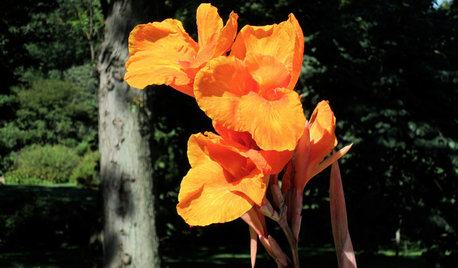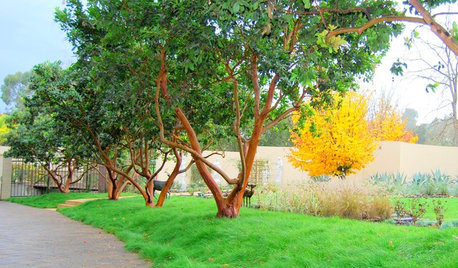Using Milorganite on Bananas-For the Ultimate Growth!
the_virginian
15 years ago
Featured Answer
Sort by:Oldest
Comments (39)
staceybeth
15 years agolast modified: 9 years agothe_virginian
15 years agolast modified: 9 years agoRelated Discussions
Tallest Abysinnian banana you have grown?
Comments (26)I love that picture. My tallest outdoors is only 4 feet. The first year, it grew from a seedling to about 3-1/2 feet. Last year, I moved it up to a slightly bigger pot, but it barely grew. I think it outgrew it's pot fairly quick and was too rootbound. Compare this to a musa basjoo I planted directly in the ground, which seemed to have an impressive growth rate it's first year (about 5 feet tall). So, I guess the moral of the story is to plant them directly in the ground, plenty of compost, water and fertilizer. I still have the original Abysinnian, however, in the dark basement and I'm going to plant directly in the ground this year. Can anyone give me advice as to how to prevent leafburn? Usually one would put a potted plant outside in the shade and gradually get it used to better light. The rootball may be too heavy to continually move indoors and out, however. Thanks, Glen...See MoreWhy don't we just start a whole Milorganite forum)
Comments (3)It has been discussed at length in various forums such as compost soil and mulch and organic lawn. I think it has good coverage here in the banana forum since the results of its use on bananas speak for themselves since it is the Sh****t for awesome banana growth....See MoreBest Banana Fertilizer EVER! Milorganite
Comments (17)this was taken from an ag Canada article Sludgewatch Admin: Troubled times for Milorganite. High fuel costs for drying, lots of cities giving away free sludge pellets, (or paying people to take it), make it harder to justify making Milorganite. In 2004 there were 16,308 tons of Milorganite was sent to Florida. That's nearly half their production. And I notice that in the past, lab tests for Milorganite were coming from a laboratory that was not accredited to do tests on sludge....wonder if that is still the case. And Canada had to send back a batch of Milorganite because it was growing salmonella. But the folks at Milorganite don't even bother to test for salmonella, so how is the company going to know whether the material it is sending to Canada complies with Canada's fertilizer requirements? You see, the US allows a Class A sludge product like Milorganite to be contaminated with salmonella so long as it meets the fecal coliform counts. So wash your hands. Keep the kids away. And golfers...? You might want to keep your gloves on when you touch your balls....See MoreSummer emergency continues..Ultimate Haworthia root loss.. What to do?
Comments (17)The fungus gnats / fruit flies are likely a result of the problem, they are not the cause. The roots rotted away which provided organic food for the larvae. Haworthia have a long and extensive system of fleshy roots. If they are crammed into a small pot, which is likely because that's how most succulents are grown, they will be prone to damage. The fleshy roots are best in a medium that does not dry out completely. Those thick roots need a consistent moisture level which may not be easy to accomplish especially in a cramped pot where there are greater temperature fluctuations. Remember that roots in a pot are not at all like roots in the ground - the substrate is much less stable in a pot. Roots easily get too hot or too cold, and will often just die back without you realizing. Since these are monocots, roots are regenerated from an initiation zone at the base of the plant. This takes longer than dicots which can root more easily, in general. I would bet the roots were gone or on their way to being gone earlier this spring, you're just seeing it now. I know this from experience. Put the plant into a new substrate without any peat, something gritty with perlite, turface, etc. Place it in a shady spot and wait. New growth probably won't come until nights are cooler in September. The temp variation outdoors is MUCH healthier than growing the plant indoors at room temp. Indoors is good for tropical plants, not so good for subtropical stuff like many succulents. Good luck...See Moremarkmcb
15 years agolast modified: 9 years agostaceybeth
15 years agolast modified: 9 years agorokal
15 years agolast modified: 9 years agothe_virginian
15 years agolast modified: 9 years agostaceybeth
15 years agolast modified: 9 years agosunsetsammy
15 years agolast modified: 9 years agothe_virginian
15 years agolast modified: 9 years agoLinda's Garden z6 Utah
15 years agolast modified: 9 years agowxman81
15 years agolast modified: 9 years agosarah2000
15 years agolast modified: 9 years agoLuv My Conifers
15 years agolast modified: 9 years agothe_virginian
15 years agolast modified: 9 years agothe_virginian
15 years agolast modified: 9 years agosarah2000
15 years agolast modified: 9 years agothe_virginian
15 years agolast modified: 9 years agostaceybeth
15 years agolast modified: 9 years agothe_virginian
15 years agolast modified: 9 years agostaceybeth
15 years agolast modified: 9 years agothe_virginian
15 years agolast modified: 9 years agojoefalco
15 years agolast modified: 9 years agothe_virginian
15 years agolast modified: 9 years agostaceybeth
15 years agolast modified: 9 years agodaryljurassic
15 years agolast modified: 9 years agoNoVaPlantGuy_Z7b_8a
15 years agolast modified: 9 years agothe_virginian
15 years agolast modified: 9 years agoNoVaPlantGuy_Z7b_8a
15 years agolast modified: 9 years agothe_virginian
15 years agolast modified: 9 years agoBamatufa
15 years agolast modified: 9 years agomindysuewho
15 years agolast modified: 9 years agostaceybeth
15 years agolast modified: 9 years agoplantmasterm
14 years agolast modified: 9 years agoplantmasterm
14 years agolast modified: 9 years agojcpingu
13 years agolast modified: 9 years agothe_virginian
13 years agolast modified: 9 years agomiguel12
12 years agolast modified: 9 years agothe_virginian
12 years agolast modified: 9 years ago
Related Stories

GARDENING GUIDESGreat Design Plant: Canna 'Pretoria'
Plant this showstopping lily in your garden now for the lush feel of a tropical landscape all summer long
Full Story
GARDENING GUIDESHow to Keep Your Citrus Trees Well Fed and Healthy
Ripe for some citrus fertilizer know-how? This mini guide will help your lemon, orange and grapefruit trees flourish
Full Story
GARDENING GUIDESGarden Myths to Debunk as You Dig This Fall and Rest Over Winter
Termites hate wood mulch, don’t amend soil for trees, avoid gravel in planters — and more nuggets of garden wisdom
Full Story
GARDENING GUIDESNew Ways to Think About All That Mulch in the Garden
Before you go making a mountain out of a mulch hill, learn the facts about what your plants and soil really want
Full Story
HEALTHY HOMEHow to Childproof Your Home: A Grandmother’s Wisdom
Change kids’ behaviors, not your entire house, to keep the designs you like and prepare children for reality
Full Story
HOUSEPLANTS10 Top Plants to Grow Indoors
Brighten a room and clean the air with a houseplant that cascades artfully, stretches toward the ceiling or looks great on a wall
Full StoryMore Discussions




nucci60